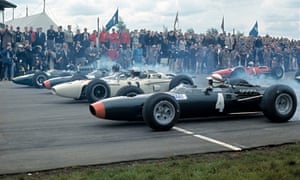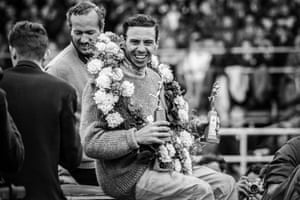
British GP, Silverstone, 1965 (from right to left): Jackie
Stewart’s BRM, Richie Ginther’s Honda, Graham Hill’s BRM and Jim Clark’s Lotus.
John Surtees’s Ferrari is in the second row. Photograph: Klemantaski
Collection/Getty Images
There is little that stirs the heart of British motor racing
fans quite like the cars Colin Chapman was making at Lotus during the 1960s.
While they will be enjoying Lewis
Hamilton’s resurgence as he attempts to win a third world
championship, he is part of a racing industry in this country that owes so much
to those heady days. And there were few that defined the era like the British
Grand Prix of 1965, when the nation owned the event and Jim Clark, Graham Hill
and John Surtees were the last British trio to complete a podium lock-out at
the race.
Next Friday is the 50th anniversary of that race when Mike
Spence and Jackie Stewart, in his debut season, made it a British top five.
Such was the home dominance, Surtees’s Ferrari was the only non British-based
car in the top 10. The success had been years in the making. Hill won his first
world championship in a BRM in 1962, Clark secured his in the beautiful Lotus
25 in 1963 and, along with Surtees, the trio had shared the top three places at
the previous two British GPs at Silverstone and Brands Hatch.
Surtees, still the only racer to have won world
championships on bikes and inFormula One, had joined
Ferrari in 1963, and was the only driver preventing Lotus, BRM, Cooper and
Brabham from flying the flag. His world championship came the following year –
giving the three drivers one apiece when they came to Silverstone in 1965.
After Hill’s death in an aeroplane crash in 1975 and Clark’s at Hockenheim in
1968, Surtees is the only one of the three greats still alive.
At 81, fit, sprightly and with a cheerful glint in his eye,
he takes pleasure in recalling the period. He was close to Clark from the
moment he switched from two wheels to four. Chapman had invited him to Lotus in
1960 and after a second place at the British Grand Prix in
his second race, asked him to join the team. “He said, ‘You are going to be No1
and you can choose your team-mate,’” says Surtees. “So I said: Jimmy.”
Clark was with Lotus but Surtees did not take up the offer,
instead driving for another team before joining Ferrari. Unlike today,
socialising between teams was part of the fabric of the sport. “I stayed
friends with Jimmy,” says Surtees and in 1963 it was a friendship he had cause
to cherish. “Jimmy was dancing with a girl at the hotel in Spa and the music
was going and I wanted to get to bed, so I came out and had a right go at
them,” he says. “But he ended up introducing me to my first wife – I married Pat,
the girl he was dancing with, and had Jimmy as my best man.”
Relationships then were closer between drivers not least
because of the very real dangers of the sport. Hill and Clark went on to become
team-mates at Lotus but there was no acrimony to accompany their rivalry.
“There was respect for one another,” says Hill’s son, Damon, who was a child at
the time. “There was rivalry, competition but also an appreciation that the
people you were racing with were doing it because they loved something. Even if
you could get killed doing it, they would still want to do it, which is
extraordinary.”
“It’s dangerous enough as it is without having someone who
would like to see you dead racing against you. So that was not the way they
went racing.”
Surtees also acknowledges Hill’s skill. “Graham was always
going to give a good performance and keep the pressure on,” he says. “Perhaps
not with the ultimate speed but certainly he would always be there and you
couldn’t take any chances and expect him to ease off.”
It is hard not to imagine he is thinking of that race in
1965 in particular, when Hill’s tenacity saw it go to the wire. Surtees was
struggling at Ferrari, with the team splitting resources in their mighty battle
with Ford at Le Mans and the car he was racing, the new 1512 with its Flat-12
engine, needed development. His rivals were moving ahead and it was the British
industry in the lead.
“F1 had been reborn in this country,” he says. “Before that
you had the Germans and Italians dominating, then Coventry Climax came along
with an engine and that was the basis on which Lotus and Cooper and Brabham all
developed their championship contenders.”
“I was aware of the piggy-back situation that existed – each
of these teams were out making little gains and piggy-backing on each other and
becoming more and more competitive. It transformed British motorsport and grand
prix racing and created the motorsport industry which is now a major one in
this country.”
An industry that proved its might at Silverstone 50 years
ago, when the drivers had to bring everything to bear to manhandle the cars.
“You try and go along and become part of it,” says Surtees. “Through the seat
of your pants and the way your hands are on the steering wheel, you get that
essence of what the car is telling you and that is how you decide how close to
the limit you can go and what the limit is.
“At times there are places where you can relax and other
times where you have to tell it you are in charge and hold on to make certain
outside forces don’t send you off. You have to bring the physical side.”
Hill’s BRM was quick but Clark was too strong. “Jimmy and
the Lotus were the combination which was formidable, no doubt about it,” says
Surtees. “Jimmy was someone who wouldn’t make many mistakes and was also quick.
He was the most competitive person out there.”
Jim Clark celebrates after winning the 1965 British
Grand Prix at Silverstone. Photograph: David Newell Smith for the Observer

Jim Clark celebrates after winning the 1965 British Grand Prix at Silverstone. Photograph: David Newell Smith for the Observer
So it proved. Clark started from pole and quickly pulled
away from the field but a misfire after 50 laps saw Hill haul him in. The
latter had a brake issue, too, but could not resist the challenge and flew
after Clark, breaking the lap record, but it was not quite enough. Clark took
the flag by three seconds.
“I would have been prepared to risk blowing up rather than
see Graham pass me,” Clark said afterwards, as far from the controlled measures
currently foisted on modern F1 drivers as it is possible to imagine. He went on
to be the first of the three to take a second title, winning six of the first
seven races that season. And the seventh? Well that was Monaco – a race he
missed because he was away winning the Indy 500. He remains the only driver to
have won at the Brickyard and the F1 championship in the same season. Another
feat unlikely to be repeated from that extraordinary group of drivers and from
a time that, unsurprisingly, many remember as British motor racing’s golden
age. “They were all drivers of the highest standard,” says Surtees with a
smile. “They had different characteristics but were always people you would
watch. But in those days it was largely down to performance. Today you need so
much initial backing that a lot of talent is lost along the way.”
The Henry Surtees Foundation was established by John Surtees
after the death of his son Henry during a Formula 2 race in 2009; henrysurteesfoundation.com
source: http://www.theguardian.com/sport/2015/jul/03/british-grand-prix-1965-heady-era-home-drivers
by Giles Richards
http://www.fzrestoration.com
No comments:
Post a Comment